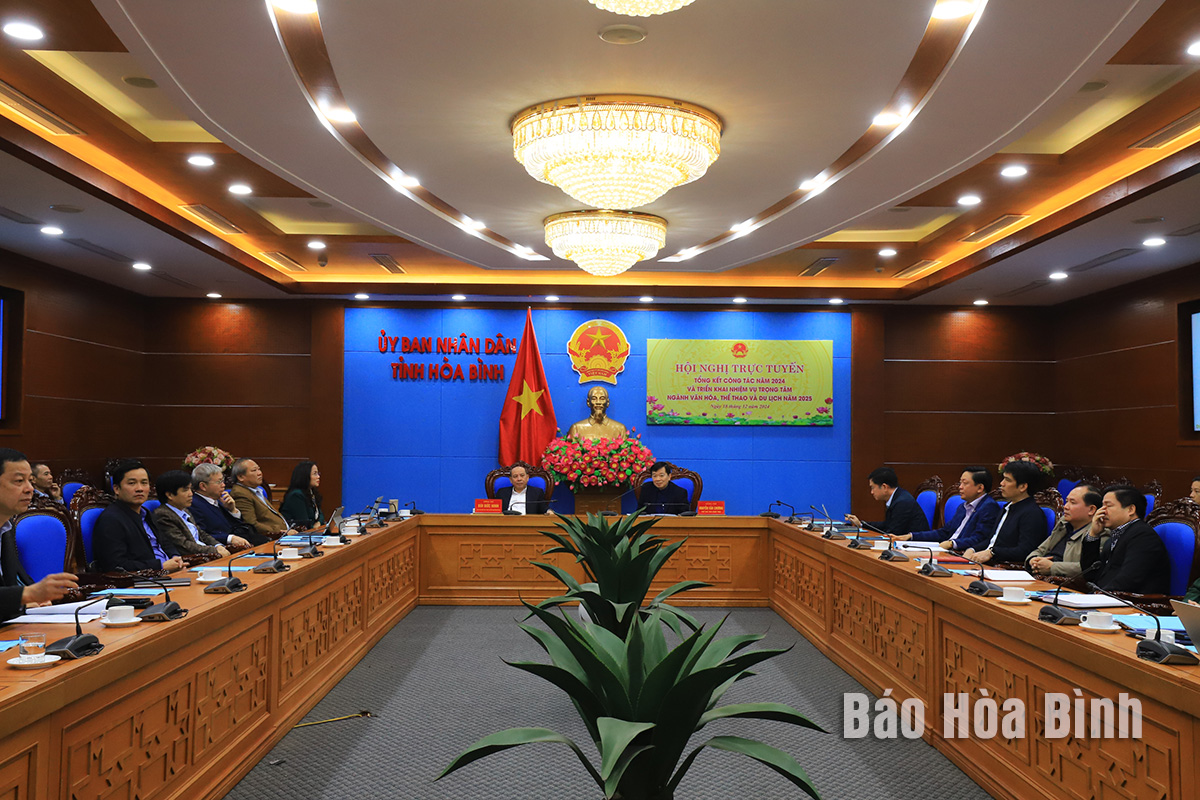
Prime Minister Pham Minh Chinh attended a hybrid conference on December 18 to review the culture, sport, and tourism sector’s performance in 2024 and launch key tasks for 2025. Standing Deputy Secretary of the Hoa Binh provincial Party Committee and Chairman of the provincial People’s Council Bui Duc Hinh, Vice Chairman of the provincial People’s Committee Nguyen Van Chuong and officials from local departments and sectors also took part in the event.
Hoa Binh
officials attend the hybrid event.
The sector demonstrated remarkable achievements
in 2024, working under the motto "dedicated - professional - skillful -
modern - united - disciplined - accelerating to realise the set goals." Particularly impressive strides have been
recorded in sports, with 1,214 international medals secured throughout the
year.
Meanwhile, Vietnam has welcomed 17.5 million
foreign tourists in 2024, up 38.9% year on year, and around 110 million
domestic visitors, up 1.6% year on year. Total revenue from tourism is
estimated at around 840 trillion VND (33 billon USD), an increase of 23.8%
compared to the same period last year.
This year, the Ministry of Culture, Sports and
Tourism has signed 11 international cooperation agreements and developed 14
plans for foreign relations activities. A multitude of exchange events and
international cooperation activities initiatives have been held successfully to
promote Vietnam's image globally and strengthened the country's international
standing.
At the event, PM Chinh spoke highly of the
sector’s efforts that have contributed to the nation's socio-economic
development despite various challenges. He asked the sector to promote its pivotal role
in revitalising the Vietnamese culture in the new era while preserving and
enhancing the distinctive values of Vietnam's culture with rich national
identity.
Looking ahead to 2025, the Government leader
outlined key priorities for the sector, including institutional reform,
administrative procedure streamlining, and increased investment in
infrastructure development, particularly in the tourism sector. He also
stressed the importance of developing specialised policies for training
cultural professionals and sports talents, while calling for resources to
develop cultural industries as well as create breakthroughs in 2025.
The clothing of women reflects the culture of the Muong, Thai, Tay, Dao, and Mong ethnic groups in the northern province of Hoa Binh.
Gongs hold a special place in the cultural and spiritual life of the Muong ethnic people in Hoa Binh province. More than musical instruments, they are an indispensable part of community rituals and collective memory, echoing through generations as a spiritual thread linking the past, present, and future.
Preserving and promoting the cultural values of the Muong ethnic group has become an urgent task in the current context, as many traditional values face the risk of fading away. This effort requires not only protecting the cultural identity but also eliminating outdated customs and developing a modern cultural lifestyle, contributing to sustainable values for the Muong community in Hoa Binh province.
The Muong ethnic culture, deeply rooted in Vietnam’s mountainous north, continues to be preserved and revitalised by dedicated individuals and communities determined to safeguard their ancestral identity.
The Muong group is one of the largest ethnic minorities in Vietnam, primarily found in Hoa Binh province. The Muong people in Hoa Binh boast a rich and diverse cultural treasure that reflects the unique identity of this ethnic group. Accounting for over 63% of the province's population, they have created and preserved numerous distinctive cultural values, contributing to their unique identity. Their cultural heritage is an invaluable asset, at the heart of their national identity, and represents a vibrant spiritual life that must be preserved and promoted in today’s modern world.
For generations, the ethnic communities of Hoa Binh province, particularly the Muong people, have preserved vibrant festivals deeply intertwined with the region’s geography, nature, and social traditions. These celebrations enrich Hoa Binh’s spiritual life and cultural identity, reflecting both folk beliefs and the intermingling of ethnic customs. Many of these festivals have endured the test of time, passed down through generations and continuing to thrive today. Among them, the Khai Ha (Going Down to the Field) festival stands out as one of the most significant events of the Muong ethnic group.



